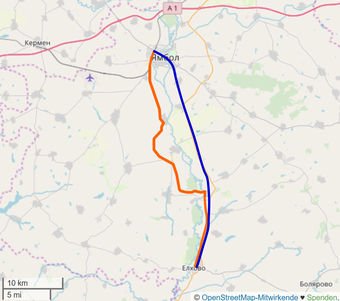Narrow-gauge railway Yambol – Elchowo
| Yambol-Elkhovo | |||||||||||||||||||||||||||||||||||||||||
|---|---|---|---|---|---|---|---|---|---|---|---|---|---|---|---|---|---|---|---|---|---|---|---|---|---|---|---|---|---|---|---|---|---|---|---|---|---|---|---|---|---|
|
Narrow-gauge railway Yambol – Elchowo, 1917
| |||||||||||||||||||||||||||||||||||||||||
|
Route of the narrow-gauge railway (blue)
and the standard- gauge railway (orange) | |||||||||||||||||||||||||||||||||||||||||
| Route number : | 84 | ||||||||||||||||||||||||||||||||||||||||
| Route length: | 39.590 km | ||||||||||||||||||||||||||||||||||||||||
| Gauge : | 600 mm ( narrow gauge ) | ||||||||||||||||||||||||||||||||||||||||
| Maximum slope : | 37.8 ‰ | ||||||||||||||||||||||||||||||||||||||||
|
|||||||||||||||||||||||||||||||||||||||||
The narrow-gauge railway Jambol-Elchowo was a 39½ km long narrow-gauge railway with a gauge of 600 mm from Jambol to Elchowo in Bulgaria .
history
The Yambol – Elchowo railway line was planned as a standard gauge line around 1910 . After the mobilization announced in 1912, the railway construction company was instructed to move a railway line on the road from Yambol to Kasatlagach for the transport of troops along the southern border. Therefore, rail material of the type " Decauville " ("дековилен") with 600 mm gauge was procured. After the outbreak of hostilities and the urgent need to transport soldiers and supplies to the southern border, the order was given to start building a normal-gauge line (1435 mm), after which the unneeded narrow-gauge railroad tracks and sleepers of the construction project for the construction of the Mesdra - Vidin railway line was used. However, the rapid turnaround of events necessitated the abandonment of the construction of the standard-gauge railway that had begun.
During the First World War , the need for military transport arose again and the construction of the railway line was resumed. From December 14, 1916 to March 31, 1917, a 600 mm narrow-gauge railway with a total length of 39½ km, operated as a horse-drawn railway , was built at breakneck speed on the shoulder of the Yambol – Elchowo road . The line began at Yambol station on the Plovdiv - Burgas railway line and was used for passenger transport within the urban area. There were a total of 7 stations with different distances between 2.16 and 12.55 km. In addition to reception buildings in the train stations of Yambol, Okop (Окоп), Tenewo (Тенево), Bejowo (Бейово) and Elchowo, horse stables were also built. Later, due to the large distance between Bejowo and Elchowo, a new station was opened at Enibegli (Енибегли). The operation of the horse-drawn railway was carried out with 160 horses and 64 four-axle and two-axle wagons, which are pulled by teams of 2 or 4 horses. The wagons were pulled by horses until the track was dismantled in April 1930.
Route
At the beginning of the narrow-gauge railway was the reloading station, which was located on the standard gauge line at Yambol station. It ran on the left shoulder of the road to the Tundja River (0.580 km). Then it went along the city street, where the greatest incline was (54.2 ‰ with a length of 50 m) to the barracks at the southern end of the city (2.760 km). From here to its end in Elchowo, the route ran along the left shoulder on the street. This avoided the construction of bridges and culverts along the entire length of the route, which also had an impact on its profile. In the direction of Elchowo the greatest gradients had a gradient between 19.2 ‰ (over 330 m length) and 31.5 ‰ (over 98 m length) and in the opposite direction between 14 ‰ (over 180 m length) and 37.8 ‰ ( on 150 m length).
business
With the Law Regulating the Status of Military Railways , which was built during the First World War, the infrastructure, along with several others, was handed over to the Bulgarian State Railways for public use in 1920 . It was taken over by this on December 1, 1920. The travel time between the endpoints was approximately 5 hours in both directions, of which approximately 1 hour was required for changing horses, waiting at the stations and waiting for oncoming traffic.
The volume of traffic peaked in the first half of the 1920s and then declined. In the spring of 1930, the traffic was stopped when the standard gauge line between Jambol and Elchowo was put into operation. After the closure of the narrow-gauge line, there were no more horse-drawn trams on the Bulgarian State Railways.
Standard gauge railway
In 1922 new plans were drawn up for the construction of a standard gauge line. Construction began in 1930, but was slow due to lack of funds. Their total length was 43,007 km with a minimum curve radius of 250 m and a maximum gradient of 15 ‰. The opening took place on April 19, 1931. Passenger traffic was discontinued in 2002 and freight traffic in 2009.
Individual evidence
- ↑ Симеонов, Начо. Железопътният транспорт в България - 1866 - 1983 година. София, Държавно издателство "Техника", 1987.
- ↑ Деянов, Димитър. Железопътната мрежа в България - 1866 - 1975 година. София, ВТУ „Т. Каблешков “, 2005.
Coordinates: 42 ° 29 ′ 44.5 ″ N , 26 ° 29 ′ 29 ″ E

